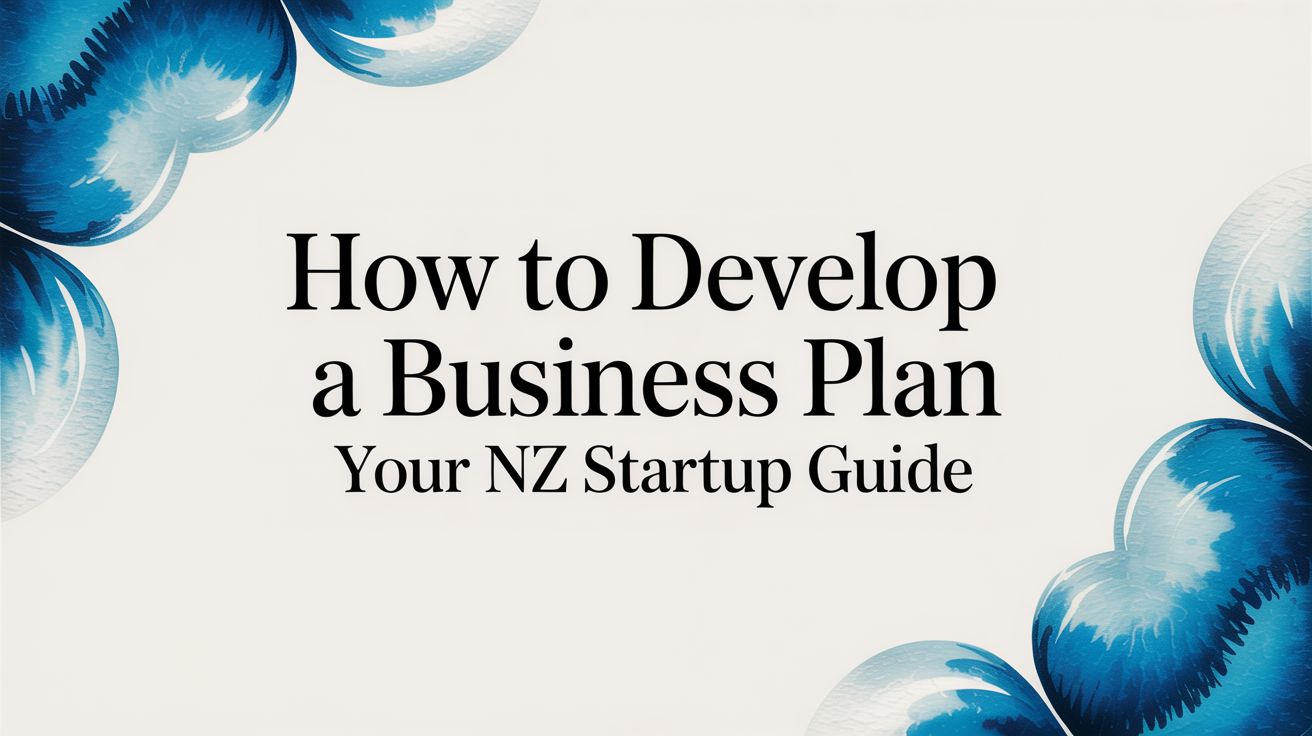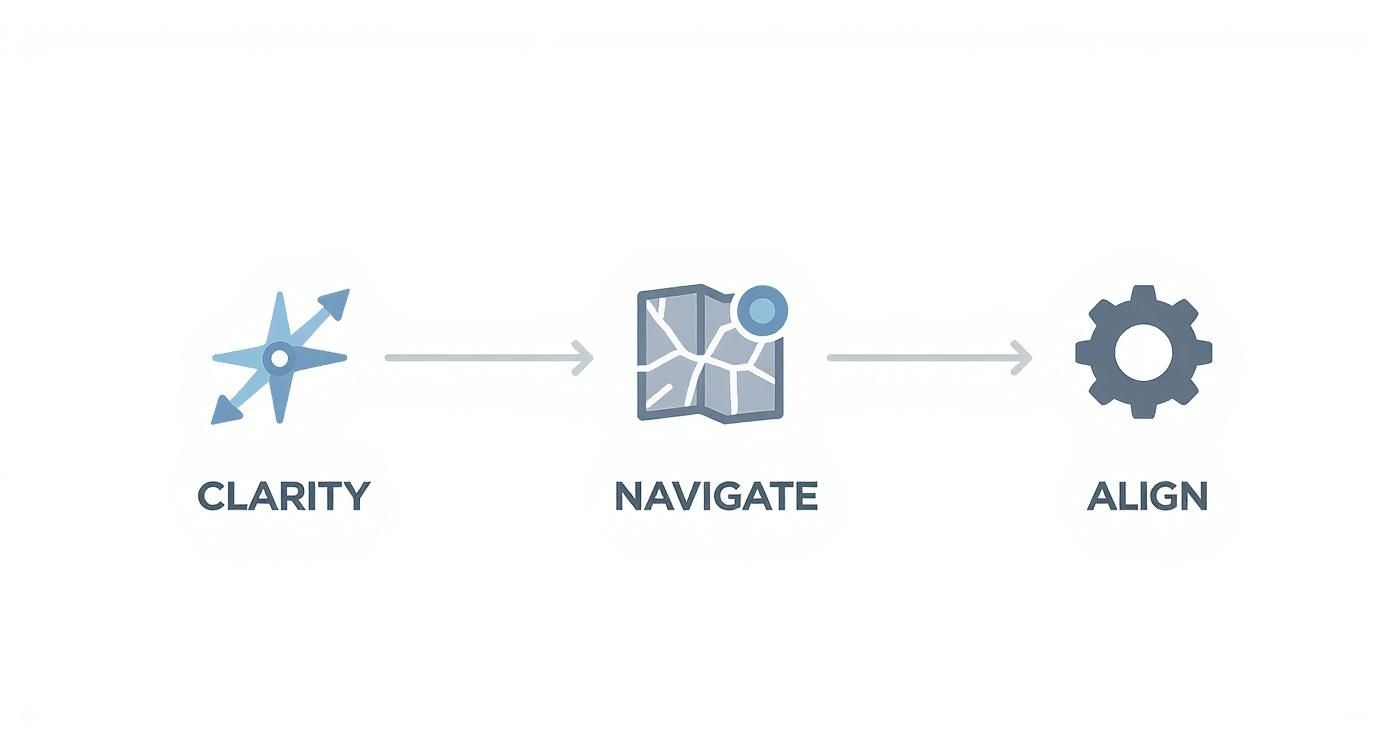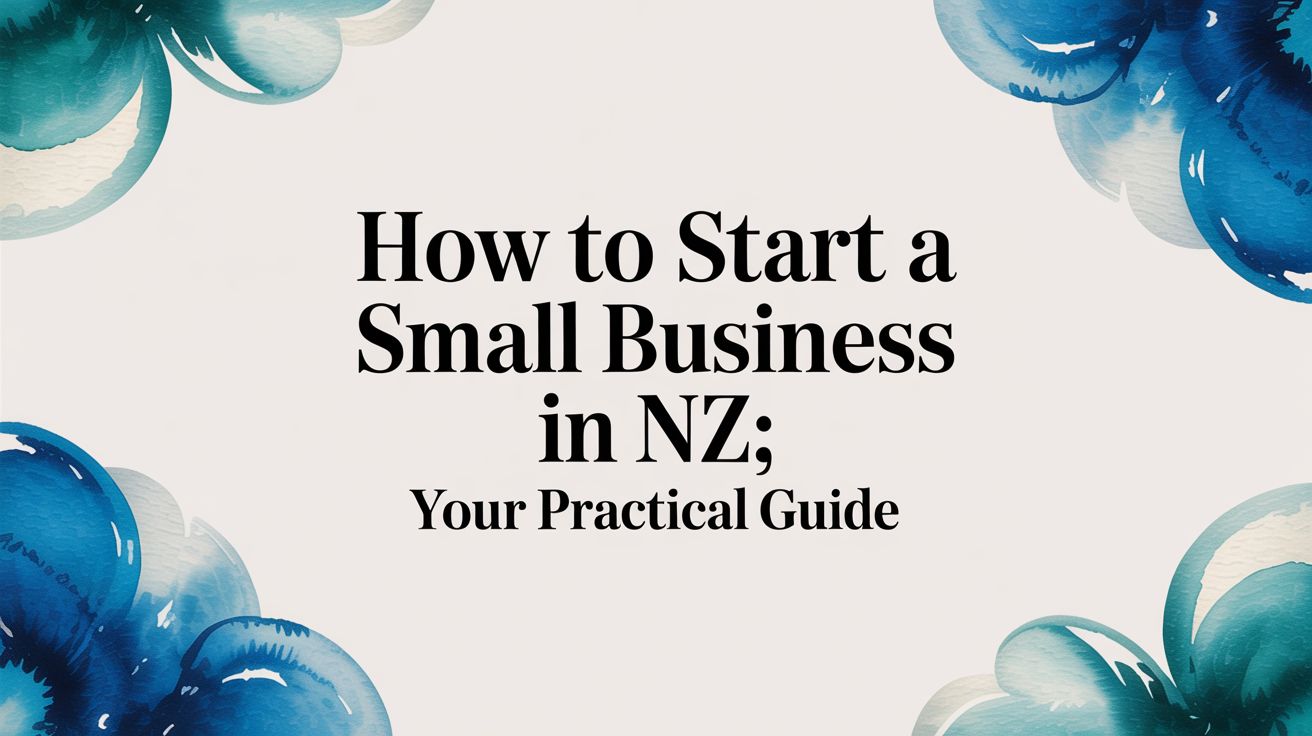
How to Develop a Business Plan Your NZ Startup Guide
Crafting a business plan is really about digging into a few key areas: getting to know your market inside and out, nailing down your strategy, crunching the numbers for your financials, and mapping out how you’ll actually run the place. Think of this document as your strategic compass. It guides every decision you make, from day one to future growth, and it’s what you’ll need to get funders on board or just keep your team on the same page. The whole exercise forces you to get brutally honest about every single part of your business.
Why Your Business Plan Is a Strategic Compass
So many Kiwi entrepreneurs I talk to see a business plan as just another piece of paper for the bank. And yeah, it’s absolutely essential for getting a loan, but its real power is the clarity it gives you. It’s so much more than a box to tick; it's the actual blueprint for turning a good idea into a business that can weather the storms.
Trying to run a business without a plan is like trying to navigate the Cook Strait in a dinghy with no map. You’re just reacting to whatever comes your way instead of seeing it coming. A solid, well-researched plan makes you look down the road, spot potential icebergs, and figure out how to steer around them before they sink you. It forces you to get crystal clear on what you do, who you do it for, and what makes you different.
Gain Clarity and Direction
The simple act of writing a plan takes all those brilliant ideas swirling around in your head and puts them into a structured, concrete framework. This clarity isn't just for you—it's vital for getting your whole team pulling the waka in the same direction. When everyone knows the destination and the route to get there, decision-making becomes sharper and way more effective.
A business plan isn't about having a crystal ball that perfectly predicts the future. It’s about building a solid framework so you can make smarter decisions when the future inevitably throws you a curveball. It's your guide, not gospel.
A Tool for Growth, Not Just a Document
Your business plan should be a living, breathing thing. It's a dynamic tool you'll come back to and tweak as your business grows and the market shifts—something that happens all the time in New Zealand’s unique economic climate. A strong plan will help you answer the tough questions:
- Your Target Market: Who are your ideal customers here in NZ, really? What do they actually need?
- Your Competitive Edge: How are you going to stand out from the local competition?
- Your Financial Viability: Can your idea actually make money, considering local costs and what Kiwis are willing to pay?
The stats for Kiwi startups really drive this home. A lack of clear strategy is a major reason so many new ventures struggle. In fact, NZ businesses that put in the hard yards with proper planning often report much healthier revenue growth than those who just wing it. If you need some foundational knowledge before you dive in, have a look at our guide on how to start a small business in NZ.
Right then, you've got your 'why' sorted. Now it's time to put some meat on the bones and build the actual framework of your business plan.
Think of it this way: a good plan tells a story. It needs a logical flow to pull in investors, partners, and, most importantly, to keep you on track. Each part should naturally lead to the next, creating a complete picture of your business vision and its potential to succeed here in NZ.
Before you get too deep into writing, it's a smart move to consider conducting a thorough feasibility study. Honestly, this can save you a world of pain and money down the line by confirming that people actually want what you're planning to sell.
A business plan is more than just a document you file away. It’s a living tool that helps you find clarity, navigate the market, and get your whole team pulling in the same direction.

This process shows that a plan isn't just about writing; it's the strategic thinking that turns a good idea into a real, operational business.
To help map this out, here’s a quick rundown of the essential sections every solid New Zealand business plan should have.
Essential Sections of a New Zealand Business Plan
Getting these core parts right will give your plan the solid foundation it needs to guide your decisions and impress anyone who reads it.
Crafting Realistic Financial Projections
Numbers tell a story. In your business plan, they tell the most important one: will this venture actually make money? This is where your brilliant idea meets the cold, hard reality of costs and revenue.
Don't panic. Getting your financial projections right is less about being a maths whiz and more about grounded, logical forecasting.

This section isn't just for investors or the bank; it’s your roadmap. It paints a clear picture of your financial health, helping you make smarter decisions about pricing, spending, and growth right from the get-go.
To give your plan the credibility it needs, your numbers have to be robust and realistic. You can learn how to master your business plan financial projections to ensure they stand up to scrutiny from even the toughest audience.
Building Believable Sales Forecasts
Your sales forecast is the engine of your entire financial model. Yes, it’s an educated guess, but it absolutely must be rooted in solid research and sound logic. A good way to start is by looking at the total market size here in New Zealand, then whittling it down to what you can realistically achieve.
For instance, if you're a boutique coffee roaster in Wellington, projecting sales to every cafe in the country in your first year just isn't believable. A much more grounded forecast would involve targeting 20-30 local cafes and calculating potential sales based on an average weekly order of, say, 5kg of beans each.
Here’s what to lean on for a solid forecast:
- Market Research: Dig into industry reports and check out what your competitors are doing to get a feel for sales volumes in your niche.
- Your Capacity: Be honest about what you can handle. How many products can you actually make, or services can you deliver, in a day, week, or month?
- Marketing & Sales Plan: Your projections should directly reflect your marketing plan. How many customers can you genuinely reach and convert with your planned activities?
Estimating Your Startup Costs Accurately
Underestimating startup costs is one of the fastest ways to get into trouble. You need to be meticulous here and, crucially, include a contingency fund for those inevitable surprise expenses. Think of it as your financial safety net.
To keep things organised, split your costs into two clear categories.
One-Off Startup Costs
These are the initial, one-time investments you need to make just to get the doors open.
- Business registration and legal fees
- Website design and development
- Initial inventory or raw materials
- Shop fit-out or office setup
- Essential gear like laptops, tools, or machinery
Ongoing Monthly Expenses (Overheads)
These are the recurring costs that keep the lights on and the business running month after month.
- Rent for your premises
- Salaries and wages
- Marketing and advertising spend
- Software subscriptions (think accounting, project management, etc.)
- Utilities, internet, and phone bills
It’s the small, recurring costs that often catch people out. A few software subscriptions might seem minor on their own, but they add up fast. Track everything—no matter how small—to get a true picture of your monthly burn rate.
The Three Essential Financial Statements
Once you've got your forecasts and costs mapped out, it's time to build the three core financial statements. These documents translate all your planning into a standardised financial format that banks, investors, and advisors all understand.
Profit and Loss (P&L) Statement: This shows your revenues, costs, and profit over a specific period (usually monthly or quarterly). It answers the most basic question: "Are we making more than we're spending?"
Cash Flow Statement: This is arguably the most critical one for a new business. It tracks the actual cash moving in and out of your bank account. You can be profitable on paper but still run out of cash if clients pay late, so this statement is vital for managing your day-to-day liquidity.
Balance Sheet: This provides a snapshot of your business's financial health at a single point in time. It shows what you own (assets) and what you owe (liabilities).
Stress-Testing Your Financial Model
A strong financial model isn't fragile; it should be able to withstand a few "what-if" scenarios. This process, often called sensitivity analysis, shows you've thought critically about potential risks and aren't just hoping for the best.
Ask yourself some tough questions:
- What happens to my bottom line if my main supplier hikes their prices by 15%?
- How would a 20% drop in projected sales impact my cash flow for the next quarter?
- At what point do my sales cover all my costs? This is your break-even analysis, and it's a number you need to know.
This kind of proactive planning is especially important given New Zealand’s current economic climate. For instance, while the Treasury's latest forecast points towards a recovery, ongoing inflation and stable unemployment rates mean businesses need to build in flexibility. Your plan must account for potential shifts in customer demand and rising cost pressures, especially if you’re in a key export sector like our food and fibre industry. It pays to stay informed on these wider trends.
Figuring Out Your Marketing and Operations Plan
A brilliant idea and a spreadsheet full of optimistic numbers don't mean much without a plan to make it all happen. This part of your business plan is all about the 'how'—how you'll actually find and win over customers, and how you'll manage the business day-to-day. Think of it as the bridge connecting your big vision to the real world.
Your marketing strategy and your operations plan are two sides of the same coin. Marketing is where you make the promise; operations is where you deliver on it. You absolutely have to nail both to build a business that people trust and keep coming back to.
Who Are You Actually Selling to in New Zealand?
Before you spend a single dollar on ads, you need to be crystal clear on who you're selling to. And "everyone" is not an answer. Here in New Zealand, with our unique and diverse communities, getting specific is the only way to make your marketing budget work hard.
Go deeper than just basic demographics. Instead of aiming for "women aged 25-40," narrow it down. Are you targeting eco-conscious mums in Auckland who want sustainable products? Or are you trying to reach young professionals in Christchurch who value convenience and a slick design?
To get that kind of clarity, you should be able to answer these questions:
- What’s their real problem? What specific headache or frustration does your product or service solve for them?
- Where do they spend their time? Are they scrolling Instagram, listening to podcasts on their commute, or swapping tips in local community Facebook groups?
- What makes them buy? Do they trust a recommendation from a mate, follow certain Kiwi influencers, or do they pour over detailed online reviews before making a decision?
Knowing this stuff lets you craft a message that actually connects and pick channels where they'll actually see it.
Choosing the Right Marketing Channels to Reach Them
Once you know who you’re talking to, you have to figure out where the conversation should happen. A classic rookie mistake is trying to be everywhere at once. It’s a surefire way to burn through your cash and your energy with very little to show for it. The real secret is to focus your efforts where they’ll have the biggest bang for your buck.
A local cafe in Dunedin, for example, will likely get far more customers through the door with a lively Instagram account showing off their daily baking and engaging with local foodies. That’s going to be way more effective than a generic, nationwide radio ad ever could be. On the flip side, a B2B software company targeting other Kiwi businesses would probably find more success writing expert articles on LinkedIn and running targeted email campaigns.
Your marketing strategy is about making smart, deliberate choices. It's far better to be a big deal on one or two channels where your ideal customers live than to have a weak, forgettable presence across ten different platforms.
These days, a solid digital footprint is non-negotiable for almost any business. To make sure you’re starting on the right foot, it’s worth checking out some expert advice. You can learn more by reading our guide on ten tips for a standout online presence. It'll help you put your energy where it matters most.
Mapping Out Your Day-to-Day Operations
Okay, now for the nitty-gritty. Your operations plan is the instruction manual for your business. It’s the engine room that keeps everything humming along, ensuring you can consistently deliver the quality your marketing promises.
This plan has to be practical and grounded in reality. It should clearly map out the essential processes that take your raw materials or ideas and turn them into the final product or service your customer pays for.
Start by sketching out your core workflows:
- Supply Chain Management: Who are your suppliers? What’s your plan B if they let you down? How will you manage your inventory so you’re not caught with empty shelves or a storeroom full of unsold stock?
- Production or Service Delivery: What are the exact steps for creating your product or carrying out your service? Who’s responsible for each part of the process?
- Fulfilment and Logistics: How will you pack and send out orders? Which courier companies will you rely on? What’s your process for handling returns or sorting out customer problems?
Who Do You Need on Your Team?
Even if you’re kicking things off as a one-person band, you need to think about the team you'll eventually need. Your operations plan should pinpoint the key roles required to make the whole thing work.
Take an honest look at your own skills versus what the business needs. Are you a marketing guru who needs someone to handle the finances? Or a brilliant maker who needs help with sales and answering customer emails? Don’t be afraid to admit what you’re not good at.
For each role you identify, jot down the main responsibilities and what a great job would look like. Thinking ahead like this doesn’t just get you ready for growth; it makes sure that when the time comes to hire, you bring on the right people for the right jobs. That’s how you build a solid foundation for a business that’s built to last.
Turning Your Plan Into Actionable Growth Levers
A business plan gathering dust in a drawer is a massive missed opportunity. Its real power comes alive when you stop seeing it as a static document and start treating it as your living, breathing guide to growth. This is where your well-researched strategy meets the real world, turning those great ideas into tangible results.

This final, crucial step is all about connecting your plan to actual outcomes. Instead of letting it become another forgotten file, you’ll learn how to use it as a dynamic tool for navigating the challenges and seizing the opportunities unique to the New Zealand market.
Identify Your Key Growth Levers
Let's be honest, every business has a handful of core areas that will drive most of its growth. Trying to do everything at once is a classic recipe for burnout and frustration. Your plan should help you pinpoint the specific levers you can pull to get the best bang for your buck.
Recent research on Kiwi business success shows a clear pattern. Companies that laser-focused on three specific areas—digital adoption, diversifying services, and expanding into new markets—saw consistent revenue growth. While our economy faces some productivity challenges, a focused, actionable plan is your ticket to overcoming these hurdles. You can discover more about these findings in the BNZ Growth Levers Insight Report.
So, which of these levers makes the most sense for you right now?
- Digital Adoption: This could be as simple as getting modern accounting software to claw back some time, or as big as launching a full e-commerce platform to reach customers nationwide.
- Service or Product Diversification: Can you add something complementary? For example, a landscape gardener might start offering ongoing maintenance packages to create recurring revenue.
- Market Expansion: This could mean looking beyond your local town to target a regional or even national customer base. For some, it might even be time to explore export opportunities.
Set Clear and Measurable Milestones
Once you know which levers you're pulling, you have to define what success actually looks like. Vague goals like "increase sales" are pretty much useless. Your plan needs specific, measurable milestones, often called Key Performance Indicators (KPIs).
These KPIs are what turn your lofty objectives into concrete targets. They create accountability and give you a black-and-white way to track your progress over time.
For instance, if your growth lever is digital adoption, your KPIs might look something like this:
- Increase website traffic by 20% in the next quarter.
- Achieve an average online customer rating of 4.5 stars within six months.
- Generate 15% of total revenue from online sales by the end of the year.
Your KPIs are the pulse of your business. They tell you, in no uncertain terms, whether your strategies are actually working. If you're not measuring, you're just guessing.
Establish a Rhythm for Review and Adaptation
The New Zealand market doesn't stand still, and neither should your plan. The sharpest entrepreneurs I know use their business plan as a tool for regular check-ins. This isn't about rewriting the whole thing every month; it's about getting into a consistent rhythm of review and adjustment.
Block out a recurring time in your calendar—maybe monthly for a quick check-in and quarterly for a deeper dive—to review your progress against your KPIs. This simple habit keeps your strategy relevant and helps you pivot quickly when new information comes to light.
During these reviews, get brutally honest with yourself and your team by asking some direct questions:
- Are we hitting our targets? If not, why?
- What's changed in the market since our last review?
- Are our initial assumptions still holding up?
- What new opportunities have popped up that we should consider?
This disciplined approach is what transforms your plan from a one-time project into an ongoing strategic process. It becomes the central tool you use to steer the ship, making informed decisions that lead to sustainable, intentional growth. For those looking to sharpen the skills needed to lead these strategic conversations, exploring practical training can be a game-changer. You can find a range of practical courses to help you build your business acumen.
FAQs: Your Business Plan Questions Answered
Even with a solid draft in your hands, a few practical questions often bubble up. Think of this as the final polish – a quick-fire round answering the most common queries we get from Kiwi entrepreneurs just like you. It's all about ironing out those last few details so you can finalise your plan with confidence.
How Long Should My Business Plan Be?
There's no magic word count. The golden rule is simple: as long as it needs to be, and not a word longer. The perfect length really comes down to who you're writing it for and why.
If you’re chasing funding from a bank or an investor here in New Zealand, you're probably looking at a traditional plan of around 20 to 30 pages. This gives you enough space to dive deep into your financial forecasts and market analysis without sending your reader to sleep.
But if it's an internal document to get your team on the same page, a lean, stripped-back plan might be all you need. Sometimes, just a few pages covering the core strategy and key numbers does the trick.
The real goal here is clarity, not cramming in pages. A sharp, powerful 15-page plan will always win over a rambling 50-page document that's lost its way. Focus on quality, not quantity.
How Should I Tailor My Plan for Different Audiences?
Your business plan isn't a one-size-fits-all document. The smartest founders tweak their plan to speak directly to the person reading it. After all, an investor cares about very different things than your new operations manager.
For Investors: They have one thing on their mind: return on investment. Your executive summary needs to hook them immediately, and your financial projections have to be rock-solid. You need to shout about your competitive edge and how you're going to scale.
For Bank Loans: Bankers are all about managing risk. They need to see a crystal-clear path to getting their money back. Make sure you highlight your break-even analysis, strong cash flow forecasts, and any collateral you can offer. Your plan should practically radiate stability.
For Your Internal Team: This is your roadmap, not a sales pitch. Zero in on the operational plan, set clear goals (KPIs), and reinforce the company’s mission. This version is all about getting everyone aligned and focused on execution.
How Often Should I Update My Business Plan?
Think of your business plan as a living, breathing document – not something you write once and shove in a drawer. Markets change, new competitors pop up, and your own goals will shift. Keeping it fresh is the only way it stays useful.
Here’s a good rhythm to get into:
- A Quick Glance Monthly: Check in on your key metrics. How are you tracking against your goals? A quick look is all it takes.
- A Deeper Dive Quarterly: Every three months, set aside some proper time to review the whole plan. It’s the perfect chance to see what’s working, what’s not, and make strategic adjustments.
- A Major Overhaul Annually: At least once a year, give the entire document a thorough refresh. This is when you'll map out new long-term goals and update your market analysis and financial forecasts for the year ahead.
What Are the Most Common Mistakes to Avoid?
Sometimes, knowing what not to do is just as important. When you're figuring out how to develop a business plan, dodging these common slip-ups will put you leagues ahead of the pack.
Unrealistic Numbers: Wildly optimistic sales forecasts and massively underestimated costs are giant red flags for anyone reading your plan. You must ground every single number in solid research and be brutally honest about the challenges ahead.
Forgetting the Competition: Claiming you have "no competition" is a rookie error. It immediately tells an investor you haven't done your homework. Every single business has competition, even if it’s indirect.
A Weak Executive Summary: This is a big one. Many people will only read your executive summary. If it’s weak, confusing, or just plain boring, they won’t bother reading the rest of the plan you’ve poured your heart into.
By getting these common questions sorted, you can turn your draft into a powerful, professional document that genuinely works for your business.
At Prac Skills, we're all about helping Kiwis turn brilliant ideas into successful businesses. Our online courses are built to give you the practical, market-ready skills you need to get ahead. See our full range of career-focused learning at https://www.pracskills.co.nz.
.webp)

